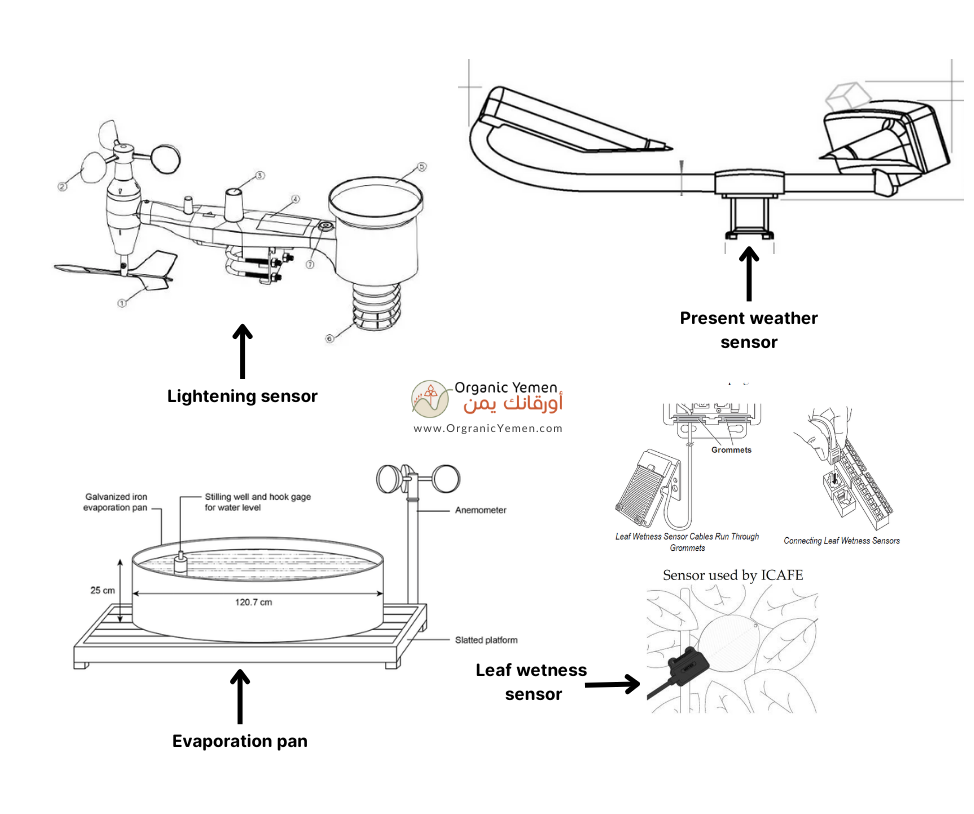Introduction To Weather Stations
A weather station is a facility, either on land or water, with sensors and technology for measuring environmental parameters for weather predictions and analyzing temperature and precipitation. Weather stations are for aviation, agriculture, weather forecasting, and meteorology.
Weather stations outperform costly and unreliable satellite data in terms of Yemen weather prediction. Organic Yemen provides services for installing weather stations, their maintenance, and upgrades, improvements to communications, and the development and training of software used by the stations.
Seiyun Agriculture Research Association Weather Station Istalled by OY
Why Use Weather Stations?
Weather stations measure the temperature, moisture content, air pressure, wind conditions, and precipitation. In addition to meteorology and aviation, weather stations are very useful in a wide range of fields. Here are a few examples of potential uses
Agriculture - Agrometeorological stations are equipped with sensors for monitoring crops.
Crop insurance - By monitoring the temperatures, you will be prepared to protect plants from extreme circumstances and optimize irrigation for better yields.
Climate change study - The climatic data illustrates the effects of a changing climate on the hydrological cycle and the ecosystems of waterbodies.
Flood early warning - Yemen weather stations keep tabs on the ongoing hydro-meteorological condition and send out early warnings to residents in potentially dangerous locations.
Renewable energy study - Data from renewable energy systems, such as wind, solar, and temperature is correlated with energy characteristics to enhance research.
Campbell Scientific Weather Station Installed by OY at Ibb University
Benefits Of Weather Stations Over Satellite Data
If you want to know what the weather is going to be like, a weather station is a better option than relying on data from a satellite station thousands of miles away. Research also reveals that distributed ground weather stations outperform satellite-based data for monitoring rainfall, wind speed and direction, temperature, humidity, and pressure.
How Many Weather Stations Are Necessary?
According to the data presented in the above graph, a typical country houses hundreds or even thousands of weather stations.
Who Needs A Weather Station?
Everyone needs a weather station. An institutional weather station is used for aagriculture, aviation, and meteorology, whereas home weather stations are for private or research purposes.
Reasons you need a weather station:
To learn about your local weather and climate.
In order to know when to sow and harvest crops.
To trigger home automation gadgets.
To provide alerts about extreme weather risks.
Why you need a weather station ?
Typical Weather Station Parts
The following instruments are commonly seen in weather stations:
Thermometer for determining air and surface temperatures.
Barometer for assessing atmospheric pressure.
Hygrometer for measuring humidity.
Anemometer for gauging wind speed.
Pyranometer for detecting solar radiation.
Rain gauge for monitoring liquid precipitation over a set period.
Windsock to measure speed and direction.
The wind vane measures wind direction.
Lastem Scientific and Campbell Scientific All-In-One Weather Sensors are designed for dependability, durability, and ease of installation, and OY offers installation and maintenance services for both.
Specialized Parts
Weather stations can include as many sensors as needed for each site. Typical Yemen Campbell scientific station sensors include, but are not limited to:
Evaporation pan - Stores water for evaporation observations, useful in agriculture.
Leaf wetness sensor - Estimates the amount of moisture on leaves at the surface, which is useful for gardening and farming.
Present weather sensor - Identifies visual weather conditions, like fog, rain or hail.
Lightening sensor - Senses lightning within around 25 miles of your location. Some are also capable of estimating the trajectory of the storm’s movement.
Typical Yemen Campbell scientific station sensors
Communication
For the weather data to be useful in agriculture or weather forecasting, it must be received and analyzed in real-time. Different methods are used for this, such as cellular or DSL internet in urban areas, or VSAT in rural areas or in applications like flood early warning that need to work in all conditions.
Data Analysis
Observational data obtained by the Yemen weather station is integrated into computerized statistical forecast models. Meteorologists combine mathematics and historical weather data from the models to make forecasts.
Cloud software streamlines the whole weather monitoring process, from programming to data retrieval to display and analysis.
Allows visualization of data as graphs, patterns, and correlations.
Enables programming of automatic alerts for dangerous weather or agriculture conditions like pest or fungus attacks.
OY has partnered with many vendors and can provide solutions according to your needs.
AGRIVI - Advanced metro station with plug & play connectivity to the AGRIVI farm management software for monitoring agricultural weather data in real-time and giving recommendations to improve your farming business.
Contrail - Enterprise-level application that continuously accumulates and observes real-time precipitation level and water flow rate for Yemen flood early warning and other applications.
OY - Your Best Partner For Yemen Weather Station Needs
Reliable, local, accessible meteorological data is vital in the contemporary world with the impending threat of climate change. Forecast data obtained from weather stations:
Increases agricultural production.
Save lives with flood warnings.
Give power through renewable energy.
Unlike an iPhone, this isn't a single piece that you unpack, switch on, and start using right away. It's more of a network of sensors, communication, and data processing.
OY can meet your needs thanks to its in-depth knowledge and global partnerships. Here's what we have to offer:
Need-based system selection/planning.
Getting the best pricing from manufacturers.
Setting up station, communications, and other things.
Training on analysis software.
Maintaining/upgrading your stations.
Yemen weather station data and research assist us in better identifying problems, defining priorities, and communicating and tracking our progress in finding solutions. Let us work together to advance Yemen's development and prosperity!







